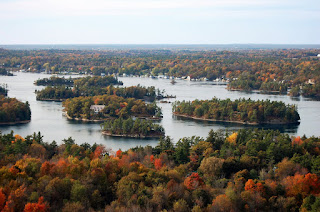2,796 miles
Oct 17 – As
I approach the metropolis of Montréal, I learn that it is built on a cluster of
islands at a place where several rivers flow together to create the great
Fleuve Saint-Laurent (Saint Lawrence River).
Laval occupies all of Île Jésus (Jesus Island)
as well as a few islands in the the Rivière des Prairies, the Îles Laval (Laval
Islands).
First, I
cross the Rivière des Mille Îles (“River of a Thousand Islands”). Is this where Thousand Island salad dressing
was created? Well, yes!
Amid several folktales about the exact
origin, most agree that this is the region where the salad dressing and
condiment originated.*
The first
European settlers were Jesuit priests who were granted a seigneury here in
1636. Laval was named after François de
Montmorency-Laval, the first Roman Catholic Bishop of Quebec.
 |
| Carrefour Laval (Laval Crossroads) Shopping Mall Designed to resemble a French city park. |
From its
agricultural roots, Laval began to grow throughout the 20th century,
based on its attraction for Montréal vacationers. As the city grew and transportation improved,
Laval’s proximity to Montréal turned it into an attractive suburb.
To deal with
problems caused by urbanization, small communities were amalgamated into larger
ones. In 1965, the Quebec government
decided to amalgamate the whole island into a single city of Laval in 1965,
even though there was local resistance.
According to
the 2011 Census of Canada, the population of Laval was then about 400,000. At that time, French was the sole mother
tongue of only 61% of the population, and the next most common mother tongues
were English (7%) and Arabic (6%). This
does not seem as strongly francophone as I had seen in the rural areas, and not
as I had expected. In community life, I
wonder how many of these English- and Arab-speaking residents use French, or do
they rely on English? This year’s census
should provide interesting results.
Laval has
been the scene of political struggles between the Québec separatists (Parti
Québécois) and the federalist Québec Liberal Party. The federalists seem to be in power now, and
likely to gain momentum with immigrants continuing to arrive.
 |
| Université Laval a fortress of learning |
I see the
influence of old Québec in the modern architecture. Many public buildings are made of gray
fieldstone, and many homes use the stone for a facing, at least. This building at the Université Laval looks
like a fortress.
The original
French “habitants” (peasant settlers) were largely from Normandy, and they
brought along their own ideas of home building.
As a practical matter, their steep roofs shed snow efficiently.
When they created porches, the roofline
developed a pretty flair at the edge, as seen on these houses in
Laval-des-Rapides.
 |
| Pont Viau across the Rivière des Prairies |
Here is the
beautiful bridge that will take me into the city of Montréal proper.
* The salad dressing also became the “Special
Sauce” in many fast food restaurants, since it contains the condiment basics of
catsup, mustard, pickles, & onions.





No comments:
Post a Comment